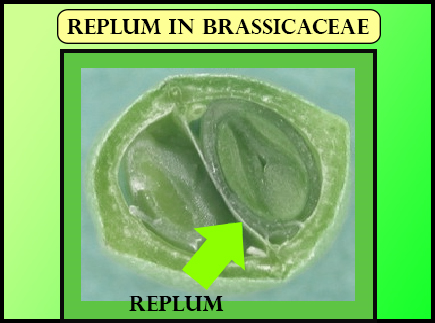
Replum is present in the ovary of the flower of
(a)Sunflower
(b)Pea
(c)Lemon
(d)Mustard
Answer
586.5k+ views
Hint: This plant is from a plant species of the genera Brassica and Sinapis in the family Brassicaceae. These plants contain flowers with four free sepals and four free alternating petals. The seeds of this plant are used as a spice.
Complete answer:
Brassicaceae family has a formation of a false septum that converts one chambered ovary into two-chambered ( basically separates the two valves of some fruits from which the valves fall away at maturity). The ovary is unilocular in the beginning but it becomes bilocular due to this false septum, and it is visible outside in a form of a rim of the seed and is known as replum. It is developed from the thalamus in place of the wall of the ovary. Out of given options, Asteraceae (Sunflower), Fabaceae (pea), Rutaceae (lemon), mustard is the genus of Brassicaceae.
Additional Information:

- Mustard is most often used at the table as an ingredient in mayonnaise, vinaigrette, marinades, and barbecue sauce. The yellow condiment known as prepared mustard is prepared by grinding and mixing the seeds with water, vinegar, or other liquids.
- Wild mustard can be used as an herb to add flavor to eggs or potatoes or to spice up oils and vinegar. But wild mustard may be poisonous to livestock and can be a serious weed problem in spring cereals. In many states, wild mustard is considered a noxious weed.
- Black mustard- taking huge amounts of these seeds by mouth can damage the throat and can also cause other serious side effects like heart failure, drowsiness, coma, and death. If it is applied to the skin for a long time, black mustard can cause skin blisters and skin damage.
-Mustard is full of minerals and contains vinegar. It also contains alkaline, which neutralizes stomach acid. It provides raw and processed foods protection against pathogenic and spoilage microorganisms.
So, the correct answer is ‘Mustard’.
Note: In angiosperms, the thalamus (receptacle) is the thickened part of a stem (pedicel) which supplies nutrients to the flower. In some fruits, for example, pome and strawberry, the thalamus gives rise to the edible part of the fruit.
Complete answer:
Brassicaceae family has a formation of a false septum that converts one chambered ovary into two-chambered ( basically separates the two valves of some fruits from which the valves fall away at maturity). The ovary is unilocular in the beginning but it becomes bilocular due to this false septum, and it is visible outside in a form of a rim of the seed and is known as replum. It is developed from the thalamus in place of the wall of the ovary. Out of given options, Asteraceae (Sunflower), Fabaceae (pea), Rutaceae (lemon), mustard is the genus of Brassicaceae.
Additional Information:

- Mustard is most often used at the table as an ingredient in mayonnaise, vinaigrette, marinades, and barbecue sauce. The yellow condiment known as prepared mustard is prepared by grinding and mixing the seeds with water, vinegar, or other liquids.
- Wild mustard can be used as an herb to add flavor to eggs or potatoes or to spice up oils and vinegar. But wild mustard may be poisonous to livestock and can be a serious weed problem in spring cereals. In many states, wild mustard is considered a noxious weed.
- Black mustard- taking huge amounts of these seeds by mouth can damage the throat and can also cause other serious side effects like heart failure, drowsiness, coma, and death. If it is applied to the skin for a long time, black mustard can cause skin blisters and skin damage.
-Mustard is full of minerals and contains vinegar. It also contains alkaline, which neutralizes stomach acid. It provides raw and processed foods protection against pathogenic and spoilage microorganisms.
So, the correct answer is ‘Mustard’.
Note: In angiosperms, the thalamus (receptacle) is the thickened part of a stem (pedicel) which supplies nutrients to the flower. In some fruits, for example, pome and strawberry, the thalamus gives rise to the edible part of the fruit.
Recently Updated Pages
The number of solutions in x in 02pi for which sqrt class 12 maths CBSE

Write any two methods of preparation of phenol Give class 12 chemistry CBSE

Differentiate between action potential and resting class 12 biology CBSE

Two plane mirrors arranged at right angles to each class 12 physics CBSE

Which of the following molecules is are chiral A I class 12 chemistry CBSE

Name different types of neurons and give one function class 12 biology CBSE

Trending doubts
One Metric ton is equal to kg A 10000 B 1000 C 100 class 11 physics CBSE

What is 1s 2s 2p 3s 3p class 11 chemistry CBSE

Discuss the various forms of bacteria class 11 biology CBSE

State the laws of reflection of light

Explain zero factorial class 11 maths CBSE

An example of chemosynthetic bacteria is A E coli B class 11 biology CBSE




